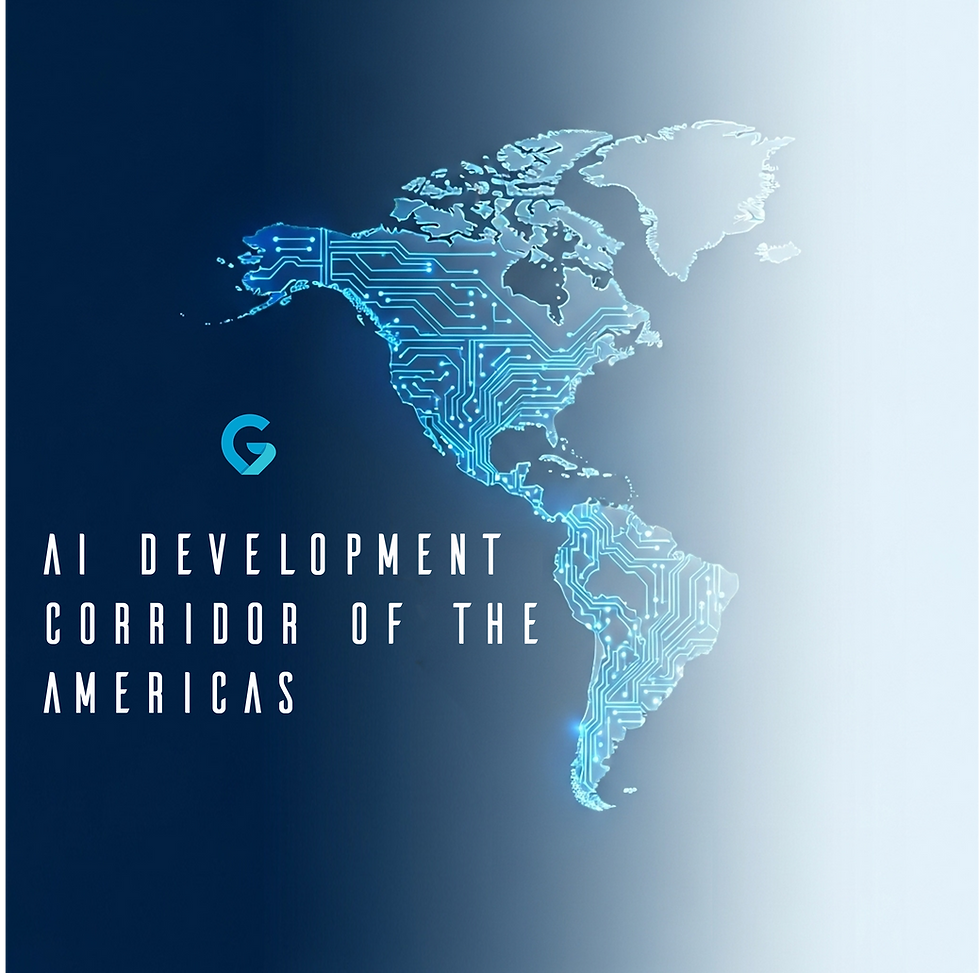Industrializing AI Beyond Borders: A Collective Blueprint for Our Future - AI Corridor of the Americas
- F CQ

- Sep 1
- 4 min read

Artificial Intelligence has already proven itself as one of the most powerful technologies of our time (and perhaps the last big invention humanity will ever need), reshaping everything from how we communicate and generate content that shapes our realities, to how we design systems that learn, adapt, and make decisions on our behalf. Yet we must be careful not to repeat the mistakes of earlier industrial revolutions. Industrialization, if pursued through silos and short-term profit motives, has a way of creating not only growth but also deep imbalances.
When brick-and-mortar industries scaled, growth was often centralized in the hands of a few nations and corporations. Whole regions were left behind, sometimes stripped of their resources without ever benefiting from the wealth their participation generated. Today, with AI, we sit at a decisive moment: will we allow a similar concentration of power, or will we build the infrastructures and frameworks that allow all regions to industrialize this technology responsibly?
AI Must Be a Shared Infrastructure
It is not sustainable for AI to be dominated by a few companies, hosted in a few countries, developed with a narrow understanding of human diversity. If intelligence is to become the defining infrastructure of the 21st century, it must be treated as a shared resource, stewarded by collaborative networks of governments, academia, startups, and communities worldwide. A commitment to reshape the Race For AI.
This doesn’t mean diluting innovation. Quite the opposite. By building interoperable standards, shared research commons, and regions empowered with compute, data, and skills, we ensure that the talent and creativity of billions are not excluded from shaping AI’s direction. This is central to building the regional AI Corridor of the Americas that links local AI innovation hubs into a truly cooperative machine learning ecosystem.
Just as electricity grids or shipping networks fueled global economic growth by spanning borders, and the internet connected people and ideas across continents, AI ecosystems must be built across geographies, not locked behind paywalls or limited to wealthy capitals of the world.
Resource Allocation for Wealth, Not Just Profit
AI requires enormous inputs: data, energy, compute, and exceptionally trained minds. The challenge before us is to allocate these finite resources in ways that serve humanity’s long-term survival and flourishing, as only equitable systems can generate enduring wealth. What good is an AI model that boosts advertising efficiency if entire communities still lack access to the most basic human necessities? What’s the point of optimizing market trades if we fail to apply the same intelligence to preserving the planet’s biodiversity, the very foundation that underpins industrial productivity and sustains our economies?
Optimizing resource allocation isn’t just a numbers game; it’s weaving a moral compass into AI’s DNA. It’s breaking down fortress-like data centers and scattering their power like seeds across diverse soils—so every region, every community, can grow its own AI harvest. After all, no abundant forest thrives with only one species. It’s crafting tools that speak local dialects, that understand the rhythm of each farm, the pulse of each clinic, and the dreams of every classroom. It’s shifting the finish line from cold economic digits to a world where humanity and nature don’t just survive, but dance in harmony.
Collaboration is the New Competitive Edge
It’s easy to fall into zero-sum thinking: if one nation dominates AI, others lose. But the reality is that AI, when industrialized responsibly, is not about one entity leading above all others but a dynamic ecosystem of competitive collaboration. A world where rivals push each other to innovate faster, yet simultaneously share knowledge and resources to solve challenges no single player could tackle alone. The true edge lies in building the networks that allow nations, companies, and communities to co-create, to share breakthroughs, and to adapt technologies for diverse contexts. To exist, coexist, and unlock collective potential beyond borders.
We’ve already seen what unchecked concentration can do: massive inequalities, fragile supply chains, and global mistrust. The industrialization of AI must reverse this pattern. It must be built as a commons, a living, evolving ecosystem that no single actor owns, but all can contribute to. Because only through shared stewardship can we ensure inclusive growth and lasting wealth that improve quality of life.
The Road Ahead is Built on Quality
Industrializing AI is not as simple as plugging in data centers. It’s about interconnected governance frameworks that ensure value creation with accountability. Ecosystems where success isn’t just profit, but meaningful impact measured across people, planet, and prosperity. It’s about education systems that empower creators and thinkers, not just consumers or spectators. It’s about energy grids fueling innovation without fueling collapse, and ambition without exploitation.
If we succeed, AI won’t just speed up productivity; machine learning will become the nervous system of global collaboration, helping us allocate resources not merely to survive, but to evolve as a species. The brain of every future system, no matter how complex or small, will carry the imprint of shared intelligence and collective care.
The challenge is enormous, but so is the opportunity. When we treat AI not as a weapon for dominance but as a shared platform for empowerment, we build a future where intelligence is industrialized equitably, inclusively, and sustainably.
AI isn’t destiny, it’s a decision!
Will you continue to allow concentration of capital and control to entrench power, or market-driven innovation to unlock broad-based opportunity?
The blueprint for tomorrow’s intelligence is unwritten. Let’s make it open, shared, and unstoppable. The road ahead belongs to all of us, wealth can be a common that we co-create and steward.



Comments